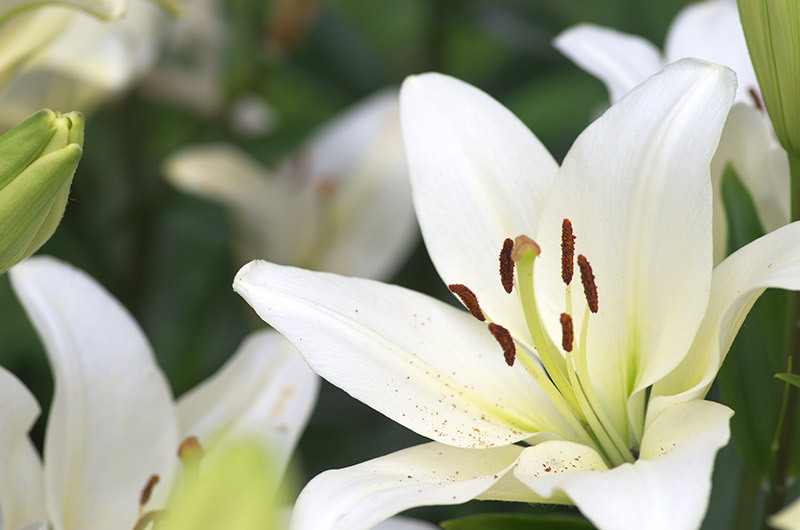Hydrangeas in bloom: care tips for gardeners
Posted on 22/08/2025
Hydrangeas in Bloom: Care Tips for Gardeners
Hydrangeas are renowned for their breathtaking blooms and vibrant colors, making them a staple in gardens across the world. Whether you're a seasoned gardener or just starting to cultivate these beautiful shrubs, understanding the best Hydrangea care practices is key to encouraging lush, long-lasting flowers. This comprehensive guide covers everything you need to know about Hydrangeas in bloom--from planting tips to maintenance, including expert advice on troubleshooting common problems. Read on to discover how to ensure your hydrangeas thrive and enchant throughout the growing season.
Understanding Hydrangeas: Varieties and Features
Before diving into care tips, it's important to recognize that not all hydrangeas are created equal. Hydrangea varieties differ in flower shape, color, and growth habits. Knowing your plant's type will guide your approach to care.
Main Types of Hydrangeas
- Bigleaf Hydrangeas (Hydrangea macrophylla): Known for their classic mophead and lacecap flowers and the unique ability to change bloom color based on soil pH.
- Panicle Hydrangeas (Hydrangea paniculata): Cone-shaped blooms, highly adaptable and cold hardy.
- Smooth Hydrangeas (Hydrangea arborescens): Native to North America and known for their large, sturdy white blooms.
- Oakleaf Hydrangeas (Hydrangea quercifolia): Notable for oak-shaped leaves and striking fall color in addition to summer blooms.
- Climbing Hydrangeas (Hydrangea anomala petiolaris): Vining types perfect for walls and arbors, with fragrant, lace-like clusters of flowers.

Essential Factors for Hydrangeas in Bloom
To enjoy abundant Hydrangea blossoms, you must provide the right combination of location, soil, moisture, and nutrition. Each aspect is critical to the overall health and vibrancy of your plant.
Choosing the Right Location
- Light: Most hydrangeas prefer morning sun and afternoon shade. Too much direct afternoon sunlight can scorch leaves and flowers, while too much shade reduces blooming.
- Airflow: Good air circulation helps prevent fungal diseases without exposing plants to harsh wind that can damage delicate blooms.
Preparing the Soil
- Drainage: Hydrangeas need moist but well-draining soil to prevent root rot.
- Organic Matter: Enrich your planting area with compost or well-decomposed manure, enhancing plant growth and bloom quality.
- pH Level: The color of some hydrangeas (especially Hydrangea macrophylla) depends on the pH. Acidic soils lead to blue flowers; alkaline soils produce pink blooms. Test your soil and amend as needed.
Planting Hydrangeas: Step-by-Step Guide
Getting Hydrangeas to bloom begins with proper planting. Here's a detailed guide to give your shrubs the best start:
- Pick the perfect spot: Choose an area with morning sun and afternoon shade, protected from strong winds.
- Prepare the hole: Dig a hole twice as wide and as deep as the root ball.
- Amend the soil: Add organic matter for improved drainage and fertility.
- Position the plant: Place the hydrangea at the same depth it was growing in the container.
- Backfill and water: Refill with soil, gently firming around the roots. Water thoroughly to settle the soil.
- Mulch: Apply a layer of mulch to retain moisture and suppress weeds.
Watering and Feeding Hydrangeas for Maximum Blooms
Timely watering and proper fertilization play a crucial role in promoting vivid hydrangea blooms.
Watering Tips
- Consistency: Hydrangeas prefer consistently moist (but not soggy) soil. Deep watering once or twice a week is better than frequent shallow watering.
- Time of day: Water early in the morning to ensure leaves dry quickly and prevent fungal problems.
- Mulching: Maintain a 2-3 inch layer of mulch to keep roots cool and conserve moisture.
Fertilizing Your Hydrangeas
- Balanced fertilizer: Choose a slow-release fertilizer formulated for flowering shrubs. Over-fertilizing can result in lush leaves but fewer flowers.
- Timing: Feed in early spring as new growth emerges, and again in early summer for repeat bloomers.
- Soil testing: Tailor your feeding based on soil nutrient levels and plant needs.
Pruning Hydrangeas: When and How
Pruning is critical for optimizing hydrangea blooming, but the correct method depends on your plant's type.
Pruning Basics for Abundant Blooms
-
Bigleaf and Oakleaf Hydrangeas:
- These types bloom on old wood (last year's stems). Prune immediately after flowering in summer, only removing dead or weak stems.
- Do not prune in late fall or early spring--the following year's blossoms form during the previous season!
-
Panicle and Smooth Hydrangeas:
- These bloom on new wood (current season's growth). Severe pruning in late winter or early spring encourages more vigorous blooming.
- Cut stems back to the lowest healthy buds without fear of removing potential flower heads.
General Pruning Advice
- Always sterilize your pruning shears to avoid spreading disease.
- Remove spent flowers (deadheading) to tidy up the shrub and sometimes encourage a second flush of blooms.
Color Control: Changing Hydrangea Bloom Colors
One of the most fascinating features of certain hydrangea species (especially bigleaf hydrangeas) is the ability to change their flower color. Here's how gardeners can influence those magical hues:
- For Blue Blooms: Soil pH needs to be acidic (5.2-5.5). Add aluminum sulfate or peat moss to encourage blue shades.
- For Pink Blooms: Alkaline soils (pH 6.0-6.2) produce pink flowers. Apply garden lime to raise the pH and limit aluminum uptake.
*Note:* White hydrangea varieties generally do not change color with soil pH.
Common Problems and Solutions
Like any garden plant, Hydrangeas in bloom can face challenges. Early identification and intervention are key to maintaining healthy, vigorous blooms.
Hydrangea Pests and Diseases
- Aphids and Spider Mites: Wash off with a forceful spray of water or treat with insecticidal soap.
- Powdery Mildew: Ensure proper air circulation and avoid wetting leaves. Fungicides may help in severe cases.
- Leaf Spot: Prune affected foliage and water at the base of the plant to limit moisture on leaves.
- Root Rot: Prevent by ensuring well-drained soil and avoiding overwatering.
Troubleshooting Bloom Issues
- No Blooms: Usually caused by improper pruning or a late spring frost damaging flower buds. Ensure correct pruning for your variety and consider protective covering in frost-prone areas.
- Weak or Small Blooms: May be due to poor soil, insufficient sunlight, or lack of fertilizer. Adjust care and provide appropriate nutrients.
Seasonal Hydrangea Care Guide
To maximize hydrangea blooms each season, follow these seasonal care tips:
Spring
- Remove winter mulch and evaluate plant health.
- Apply balanced fertilizer and prune as necessary depending on type.
- Check for winter damage and pests.
Summer
- Water regularly; mulch to retain moisture.
- Deadhead spent blooms.
- Watch for pests and treat promptly.
Fall
- Avoid fertilizing late in the season.
- Prune only if your hydrangea blooms on new wood.
- Add fresh mulch after the first frost for winter protection.
Winter
- In colder regions, cover plants with burlap or mulch mounds to protect flower buds.
- Avoid pruning except to remove damaged wood.
Hydrangea Care Tips for Container Gardening
If you don't have ample garden space, growing hydrangeas in pots is a wonderful alternative. Here's how to ensure robust blooms in containers:
- Use large pots with drainage holes and light, well-draining soil.
- Water more frequently, as pots dry out faster than ground soil.
- Fertilize monthly during the growing season for best results.
- Move pots to a sheltered area or insulate them over winter in colder climates.
Hydrangeas in Floral Arrangements
Hydrangea flowers are a favorite addition to bouquets and indoor displays. Here are tips for cutting and preserving hydrangea blossoms:
- Cut blooms in the morning when they are fully hydrated.
- Use sharp, clean shears and immediately place stems in water.
- To dry hydrangeas, hang bunches upside down in a cool, dark, and dry place.

Frequently Asked Questions
How long do hydrangeas bloom?
Most hydrangeas bloom from late spring through late summer, with some varieties such as endless summer hydrangeas offering repeat blooming into fall.
Why aren't my hydrangeas blooming?
Common causes include incorrect pruning time, frost damage to flower buds, or insufficient sunlight. Assess care practices and variety-specific needs.
Do hydrangeas need a lot of sun?
They prefer morning sun with afternoon shade, especially in hotter climates. Panicle hydrangeas tolerate more direct sunlight than other varieties.
Conclusion
Hydrangeas in bloom are an extraordinary sight in any garden, and with the right care, you can enjoy years of dazzling, healthy flowers. Remember: identifying your hydrangea type, following appropriate pruning, and maintaining the perfect balance of light, water, and soil will reward you with abundant blooms season after season. Whether you're an experienced horticulturist or a budding home gardener, use these comprehensive hydrangea care tips to turn your garden into a vibrant, floral paradise.
For more gardening inspiration and advice, explore our other butterfly-friendly, shade-loving, and perennial plant guides.
Latest Posts
A Resident's Review: Flower Delivery Experience in [POSTCODE]
Case Study: Transforming a [BOROUGH/NEIGHBOURHOOD] Business with Flowers
Achieve Extended Poinsettia Liveliness This Year





